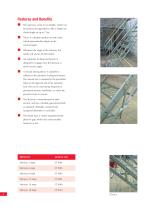
Catalog excerpts

Combisafe Site Stairway COMBISAFE the safe temporary access solution SAFETY BY SYSTEMS
Open the catalog to page 1
Combisafe Site Stairway the safe temporary access solution Regulations and Standards There has been a general move within Regulations to promote safer and easier methods for temporary access between levels in construction. The need to carry small tools and materials to and from the workplace, and the benefit of forward facing movement, have encouraged the development of the Combisafe Site Stairway The Combisafe Site Stairway has been designed and tested to meet the access performance requirements within the European Standard EN 12811 – Temporary Works Equipment - performance requirements...
Open the catalog to page 2
Combisafe Site Stairway General construction best practice, and increasing regulations, support the move away from ladders as the means of temporary access between levels on construction sites. The Combisafe Site Stairway offers a simple, safe and practical solution. The Stairways are quickly and easily installed on site, straight off the back of the transport, and are ready for use in minutes. Set up at between 25° and 50° they are used facing forward, and users can carry small tools, equipment, and materials in safety and comfort. They can be set up on table forms, in service ducts,...
Open the catalog to page 3
Features and Benefits The stairways come in six lengths, which can be joined and supported to offer a single run climb height of up to 7.5m. There is a double handrail on both sides, which automatically adjusts to the correct height. Whatever the angle of the stairway, the treads will always be horizontal. An automatic locking mechanism is designed to engage once the stairway is at the correct angle. A manual locking device is available in addition to the automatic locking mechanism. The manual lock is mounted in the pre-drilled holes on the opposite side to the automatic lock. This can be...
Open the catalog to page 4
Features and Benefits The bottom of the stringers have points to prevent slipping. The Stairway allows access for two persons at any one time. Being over 750mm wide, the Stairway permits occasional passing if required. For high passage rates the Stairways can be set up in pairs, each for one way traffic. The Stairways can be pre-joined to the required length before being sent to site, alternatively they can be site assembled. Units over 21 steps require a Combibeam for stiffness. Pre-fitting this before transport speeds up erection on site. The Stairways can be folded flat for ease of...
Open the catalog to page 5
Applications and Arrangements This highly flexible temporary stairway offers a simple and effective access solution: Between levels on scaffolding Access to table platforms Access up batters and embankments Stairways can be used in lieu of permanent stairs Access into service ducts Access to temporary site offices and portacabins Universal Support COMBIBEAM Mid Lattice Beam (M6) SIZE AND STABILITY 18-step and 21-step units require a bolton support. Units over 21 steps require a Combibeam, assembled from end modules and intermediate modules. Other special sizes can be manufactured on...
Open the catalog to page 6
INSTALLATION Two operatives can easily install Stairways up to 9 steps. 12-step units and above will require lifting equipment. The top is fixed to the upper level with one of a range of attachment devices to prevent movement in use, and the bottom of the stringers have points to prevent slipping. All the Stairway units are cross-braced between stringers for increased stability; however, it is recommended that they are erected on a flat secure surface, or onto a sole plate if on soft ground. ATTACHMENTS Slab Attachment The Slab Attachment is mounted on the stairway splice bracket to secure...
Open the catalog to page 7
Inclination Diagram The inclination diagram shall be used for selecting the stairway length. Recommended inclination range is 25-50º The example in the diagram is shown with dotted lines and shall be interpreted as follows (example within brackets): 1. Start with the total rise height required (4.2 m). 2. Follow the rise height across into the fan of recommended inclination (38º). 3. Choose the number of steps based upon the inclination required (24 steps at 38º) 4. Follow downwards from the intersection - and read off how far out the base of the stairway will be (5.3m). Stairway Length(m)...
Open the catalog to page 9
COMBISAFE DEUTSCHLAND GmbH Unit 1, Zone A, Cheaney Drive, Grange Park, Northampton, NN4 5FB United Kingdom Email: info@combisafe.co.uk Email: info@combisafe.de COMBISAFE FRANCE Email: info@combisafe.co.uk COMBISAFE INTERNATIONAL AB Ostersund Office Storsjöstråket 15 831 34 Östersund COMBISAFE DANMARK ApS Sluseholmen 2-4 2450 Kopenhamn SV Stockholm Office Email: info@combisafe.se Email: info@combisafe.se c/o Safegate Gulf L.L.C COMBISAFE ESPAÑA 4th Floor, Khalid Al Attar Building Sheikh Zaid Road Email: info@combisafe.co.uk Email: info@combisafe.co.uk
Open the catalog to page 10All Combisafe International catalogs and technical brochures
-
Filigree Attachment
2 Pages
-
1820 Flexifeet Barrier
1 Pages
-
Edge Protection Systems
2 Pages
-
Universal Stairs Brochure
4 Pages
-
New Steel Mesh Barrier Stair
2 Pages
-
Product Catalogue
152 Pages
-
Pre-Cast Attachment Flyer
2 Pages
-
Safety Net Fan
7 Pages
-
Multi Mesh Barrier
3 Pages
-
Attachments Flyer
2 Pages
-
Edge Protection
9 Pages
-
SkyReach Anchor
4 Pages
-
Counterweight System
4 Pages
-
Framed Barrier
4 Pages
-
Timber Construction Industry
6 Pages
-
Steel Industry
6 Pages
-
Rebar Socket
2 Pages
-
Precast Concrete Industy
6 Pages
-
Power Post
4 Pages
-
Net Barrier System
10 Pages
-
Counterweight Flyer
4 Pages
-
Combisafe Loading System
2 Pages
-
Civils Flyer
3 Pages
-
COMBISAFE product catalogue
144 Pages
Archived catalogs
-
Fast frame
2 Pages
-
Containment Brochure
6 Pages
-
Egde protection brochure
9 Pages
-
Steel Mesh Barrier System
10 Pages
-
Stairway
10 Pages




































